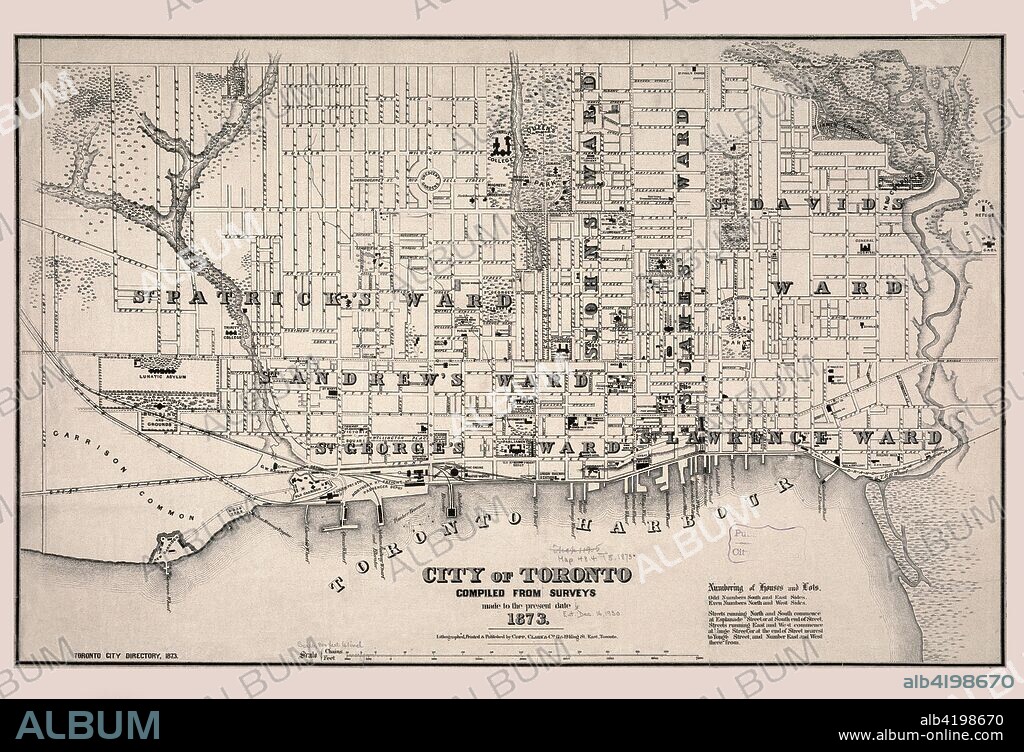alb4198670
City of Toronto: compiled from surveys 1873

|
Add to another lightbox |
|
Add to another lightbox |



Buy this image.
Select the use:

Title:
City of Toronto: compiled from surveys 1873
Caption:
Toronto, Canada's largest urban center and the capital of Ontario Province, was founded in 1791 by British Loyalists. Originally named York, the settlement was renamed Toronto in 1834 with the granting of a city charter. The city's rectangular grid pattern of streets, which was used for most United States and Canadian cities laid out in the 19th century, is depicted on this 1873 map which was published to accompany a city directory. Representative of late 19th-century urban maps, it shows the individual streets and street names, as well as the city's wards, public parks, and prominent buildings including the parliament buildings, colleges, schools, hospitals, churches, and asylums. Particularly evident are the railroads, which feed into the central business district and terminate at a number of wharves protruding into the harbor, providing evidence of the city's commercial and transportation functions. - Copp Clark Company
Credit:
Album / Universal Images Group / Universal History Archive/UIG
Releases:
Image size:
8620 x 5882 px | 145.1 MB
Print size:
73.0 x 49.8 cm | 28.7 x 19.6 in (300 dpi)
Keywords:
1791 • 1834 • 1873 • 19 CENTURY • 19TH CENTURY • 19TH CENTURY. • 19TH • 19TH-CENTURY • A • ACCOMPANY • AGENT • AND • ARE • AREA • AS • ASYLUMS • BRITISH • BUILDINGS • BUSINESS • BY • CANADA • CANADA. • CANADIAN • CAPITAL • CENTER • CENTRAL • CENTURY • CHARTER • CHURCH • CHURCHES • CITIES • CITY • CIUDAD • COLLEGES • COMMERCIAL • DEPICTED • DIRECTORY • DISTRICT • DISTRICTS • ECCLESIA • ENGLISH • EVIDENCE • EVIDENT • FEED • FOR • FOUNDED • FUNCTIONS • GARDEN • GRANTING • GREEN SPACE • GRID • HARBOR • HOSPITAL • HOSPITALS • IGLESIA • INCLUDING • INDIVIDUAL • INTO • IS • IT • LAID • LARGEST • LATE • LOYALISTS • MANAGER • MAP • MAPS • MOST • NAMED • NAMES • NEIGHBORHOOD • NINETEENTH CENTURY • NUMBER • ON • ONTARIO • ORIGINALLY • OUT • PARK • PARKS • PARLIAMENT • PARTICULARLY • PATTERN • PLAN (CARTOGRAPHY) • PROMINENT • PROTRUDING • PROVIDING • PROVINCE • PUBLIC • PUBLISHED • RAILROADS • RECTANGULAR • RENAMED • REPRESENTATIVE • ROAD • ROADS • RUA • SCHOOLS • SETTLEMENT • SHOWS • STATES • STREET • STREETS • SUBURB • TERMINATE • THE • THIS • TORONTO • TOWN • TOWNS • TRANSPORTATION • UNITED • URBAN • USED • VIA • WARDS • WAS • WAY • WELL • WHARVES • WHICH • WITH • XIX CENTURY • YORK
 Pinterest
Pinterest Twitter
Twitter Facebook
Facebook Copy link
Copy link Email
Email
